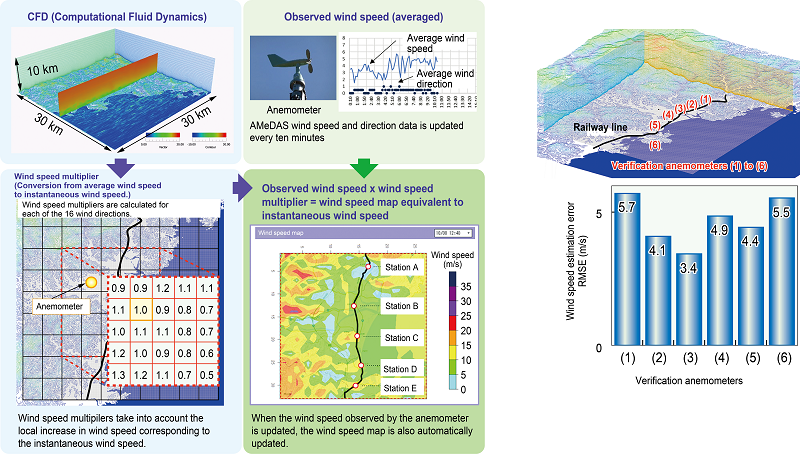5. Creation of time-varying dynamic wind maps
In light of the increasing intensity of typhoons in recent years, with stronger winds observed over wider areas, there is a need to augment wind data observed by discretely installed anemometers. In order to realize low-cost, wide-area, and detailed monitoring of strong winds, we have developed a method to create dynamic wind speed maps that change with time by combining "point" wind speeds observed from time to time by anemometers and "surface" wind speed distributions obtained by CFD (Computational Fluid Dynamics).
First, CFD is performed for each of the 16 wind directions over an approximately 30 km x 30 km analysis domain (upper left of Figure 1) that includes the location of one or more anemometers. Next, using the results of CFD, the rate of increase or decrease of wind speed (hereafter, the rate of increase or decrease of wind speed is denoted as the wind speed maltipliers.) at each analysis grid point within the domain (bottom left of Figure 1) is calculated based on the wind speed at the analysis grid point where the anemometer is located. The wind speed multipliers take into account the average wind intensity at each analysis grid point relative to the entire domain, as well as the effect of local wind speed increases at each analysis grid point. By multiplying the wind speed observed by an anemometer (upper right of Figure 1) by the wind speed multipliers, the wind speed distribution over the surface (wind speed map, lower right of Figure 1) is obtained. When the wind speed observed by the anemometer is updated, the wind speed map is also automatically updated. In addition to anemometers owned by railway companies, the Japan Meteorological Agency's AMeDAS can be used as anemometers to obtain wind speed data.
Verification with 14 cases of strong winds obtained with anemometers at six locations (Figure 2 upper) confirmed that the 10-minute maximum instantaneous wind speed can be evaluated with an error of approximately 5 m/s (Figure 2 lower).
This wind map can be used to monitor strong winds and determine operation controls for railway sections where anemometers have not yet been installed.
Other Contents
- 1. Rapid seismic damage estimation tool for large bridges
- 2. Seismic diagnostic for existing pile foundations affected by nearby excavation work
- 3. Earthquake countermeasure for poles on viaduct using stays and overhead wires
- 4. Rainfall-damaged embankment safety assessment tool
- 5. Creation of time-varying dynamic wind maps
- 6. Braking performance improvement under snow conditions by controlling wheel temperature using snowproof brake systems
- 7. Platform safety support device using side-mounted cameras
- 8. Silicon buffers on passenger cars provide longitudinal ride comfort and improved safety in train breakdown operations
- 1. Rapid seismic damage estimation tool for large bridges
- 2. Seismic diagnostic for existing pile foundations affected by nearby excavation work
- 3. Earthquake countermeasure for poles on viaduct using stays and overhead wires
- 4. Rainfall-damaged embankment safety assessment tool
- 5. Creation of time-varying dynamic wind maps
- 6. Braking performance improvement under snow conditions by controlling wheel temperature using snowproof brake systems
- 7. Platform safety support device using side-mounted cameras
- 8. Silicon buffers on passenger cars provide longitudinal ride comfort and improved safety in train breakdown operations

